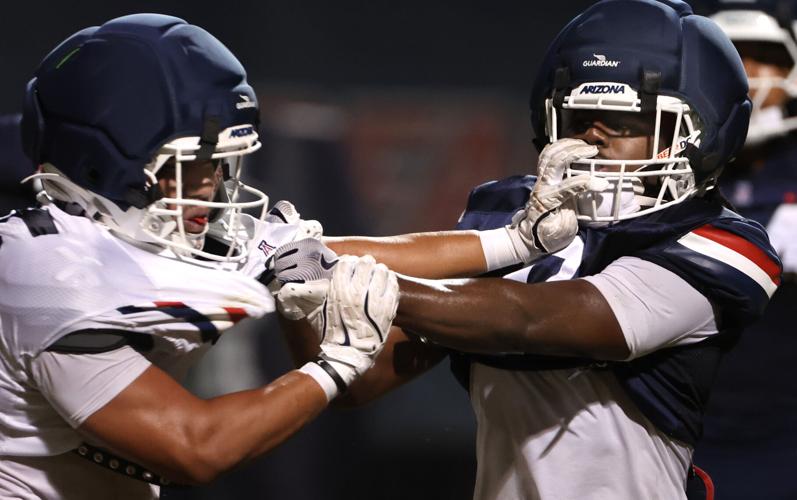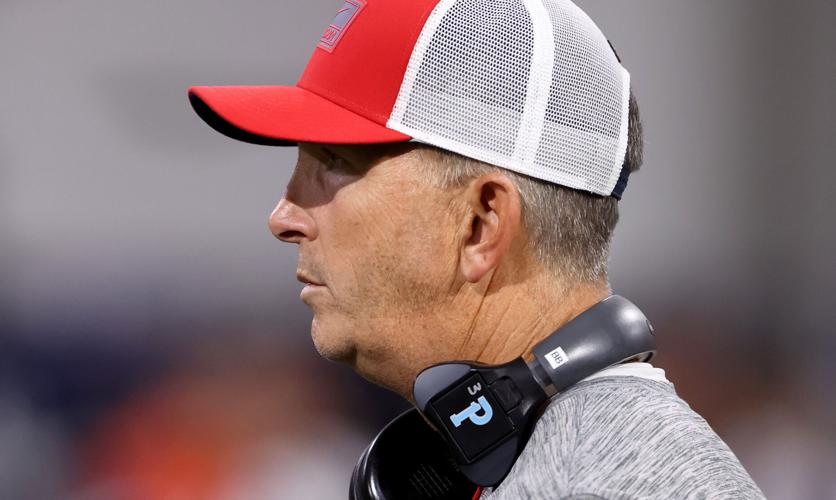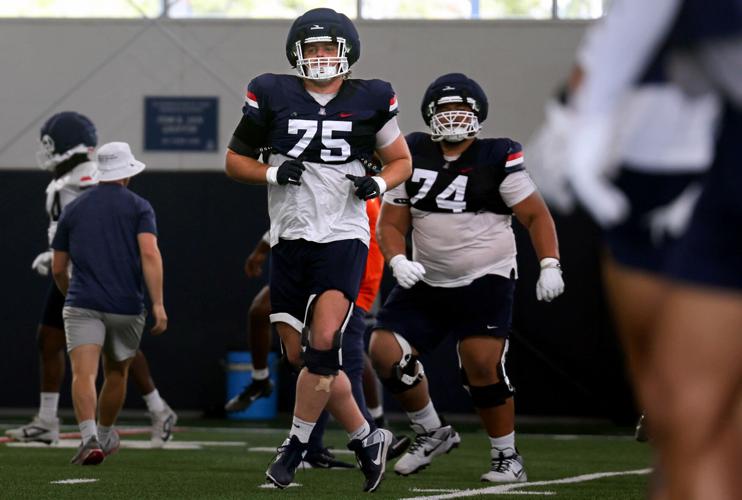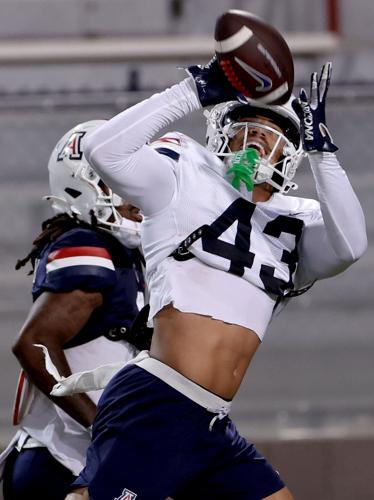College football has changed in profound and fundamental ways over the past five years.
The College Football Playoff is three times bigger. Players are being paid directly by schools. They have more freedom of movement than ever before.

Michael Lev is a senior writer/columnist for the ├█╠ęė░Ž±AV, Tucson.com and .
could slow because of the House settlement, which at least gives programs a salary floor, but I doubt it. The total number of entries has climbed every year as transfer restrictions have been eased or removed altogether.
Newly arrived freshmen ŌĆö of which Arizona has about two dozen ŌĆö are entering into a new world. Or so youŌĆÖd think.
Given the aforementioned changes, I assumed the approach to coaching and managing freshmen had shifted accordingly. After all, if they donŌĆÖt like the way things are going, they can leave without consequence as soon as the portal window opens in December.
People are also reading…
Maybe thatŌĆÖs the case at other programs. Not so at Arizona.
I asked six UA coaches in separate interviews whether theyŌĆÖre handling freshmen any differently during the transfer-portal era than before it. None said they are.
Some acknowledged that certain aspects have changed, including playersŌĆÖ readiness for college and their expectations for playing time. But all said that relationships and long-term development remain pillars of building a program ŌĆö at least this one.
ŌĆ£The hard part for all these freshmen is that they were ŌĆśThe ManŌĆÖ last year, wherever they were,ŌĆØ UA head coach Brent Brennan said. ŌĆ£They were the best player on their high school team, they were the best player in their district, they were the best player in their state. TheyŌĆÖre all super-high-level kids. But thereŌĆÖs a developmental process to getting ready to play on this level, playing in the Big 12.ŌĆØ
The timeline is different for different positions. Barring catastrophic injuries, I would expect all of ArizonaŌĆÖs freshman offensive lineman to redshirt this year. ThatŌĆÖs the norm for footballŌĆÖs most physically demanding and athletically unnatural position. Jonah Savaiinaea ŌĆö an immediate starter whoŌĆÖs now a first-team rookie for the Miami Dolphins after three years at the UA ŌĆö was an outlier. He was the rarest of Cats.

Arizona football head coach Brent Brennan watches as the team works out during an indoor session on Aug. 13, 2025.
Freshman running back Wesley Yarbrough could start this Saturday if he had to. He neither looks nor sounds like a raw rookie. Listed at 5-foot-10, 211 pounds, Yarbrough is stout and strong. In his first interaction with Tucson media last week, he spoke confidently.
ŌĆ£Whatever school I was going to go to, I wanted to be the best to ever go there,ŌĆØ Yarbrough said. ŌĆ£ThatŌĆÖs just the standard I set for myself. I want to get on the field fast. I want to get in the playbook fast.ŌĆØ
As it stands, Yarbrough is the WildcatsŌĆÖ No. 4 running back. TheyŌĆÖre likely to give three veterans ŌĆö Ismael Mahdi, Kedrick Reescano and Quincy Craig ŌĆö most of the playing time.
But Yarbrough is one injury away ŌĆö at an especially susceptible position ŌĆö from jumping into the top three. In the meantime, heŌĆÖs embracing special teams as a means to get on the field. ItŌĆÖs a must for any player ŌĆö running backs in particular ŌĆö with NFL aspirations.
ŌĆ£I take every single rep seriously,ŌĆØ Yarbrough said. ŌĆ£I make it a priority.ŌĆØ

Arizona linebacker Leviticus SuŌĆÖa, left, and running back Wesley Yarbrough tangle while working on pass rush and blocking in preseason training camp on Aug. 12, 2025.
Since 2018, coaching staffs have had another way to keep freshmen engaged: They can appear in up to four regular-season games while retaining their redshirt year.
Nowadays, that tactic carries some risk: If a player stands out in that four-game window, he could get poached by another program. General managers and other front-office types are constantly scouting other teamsŌĆÖ rosters. If a player performs well under the lights, he becomes that much more attractive on the portal market.
Staying the course
In 2021, the NCAA ratified a : Athletes in any sport could transfer once without having to sit out a year.
├█╠ęė░Ž±AV offensive tackle Ty Buchanan was part of that inaugural class. After spending his freshman year at USC, he transferred to Texas Tech.
Buchanan might have left anyway because he wanted to be closer to home; heŌĆÖs from Corpus Christi. But the rule change made the move more appealing.

├█╠ęė░Ž±AV offensive lineman Ty Buchanan (75) warms up before fall football practice inside the Davis Sports Center on Aug. 8, 2025.
ŌĆ£It helped a lot,ŌĆØ Buchanan said, ŌĆ£because I knew that I wouldnŌĆÖt be penalized if I transferred.ŌĆØ
Buchanan appeared in three games for the Red Raiders in 2022 and ŌĆś23, starting once in each season. He became a regular last year.
Even with tools at his disposal to accelerate his personal timeline, Buchanan knew it would take time and patience to establish himself. Such is the way for most offensive linemen.
Buchanan weighed 260 pounds when he enrolled at USC in July 2021. Four years later, heŌĆÖs listed at 314.
ŌĆ£ItŌĆÖs challenging,ŌĆØ Buchanan said. ŌĆ£ItŌĆÖs a process. You gotta grind every day. Get the footwork right, get your body (mass) up, all of the above.ŌĆØ
BuchananŌĆÖs position coach, Josh Oglesby, began his college coaching career in 2013. HeŌĆÖs seen the sport evolve.
The way Oglesby goes about his job hasnŌĆÖt changed. ItŌĆÖs still about building relationships and maintaining open lines of communication.

├█╠ęė░Ž±AV offensive line coach Josh Oglesby speaks to reporters on media day at the Davis Sports Center on July 29, 2025.
It starts in the recruiting process. It continues during freshman year. Oglesby wants to make sure his players have a positive experience, regardless of when (or if) they play.
ŌĆ£Part of our job is to ensure that ... they feel that theyŌĆÖre getting developed, they feel like theyŌĆÖre getting better, they feel like theyŌĆÖre on the right path to eventually earn that spot,ŌĆØ Oglesby said. ŌĆ£You also have to be upfront with those guys in recruiting. There are certain positions that are easier to play younger than others. When you talk about our position, thereŌĆÖs so much that goes into the ability of a young guy to play early.ŌĆØ
Oglesby and others said itŌĆÖs still possible to pitch a long-term development plan in the transfer-portal era.
ŌĆ£But you also have to follow through,ŌĆØ Oglesby said, ŌĆ£so that they feel that, ŌĆśOK, what you said to me in recruiting is real.ŌĆÖ Once they get here, showing them that you can add value for them.ŌĆØ
One of my colleagues believes redshirting is a waste of time these days because all youŌĆÖre doing is preserving a playerŌĆÖs eligibility for another program. ItŌĆÖs unavoidable on the offensive line.
Two of ArizonaŌĆÖs freshman linemen, Louis Akpa and Javian Goo, have shown promise during training. But those two and fellow rookie Jaxon Griffin need to put on substantial weight. The other two freshman offensive lineman need to lose a bunch.
No one wants to sit out. ŌĆ£I worked my butt off,ŌĆØ Buchanan said of his one season at USC, where he briefly moved up to second string. But offensive linemen generally accept the reality that they wonŌĆÖt play as freshmen.
ŌĆ£If you stay the course and trust the process,ŌĆØ Oglesby said, ŌĆ£your time will come.ŌĆØ
Uncertain future
Dalton Johnson figured heŌĆÖd play more as a freshman in 2021 than he did. He appeared in three games for a team that finished 1-11.
ŌĆ£Coming to U of A at the point they were at,ŌĆØ ArizonaŌĆÖs veteran safety said, ŌĆ£I felt like I could come in and make a difference.ŌĆØ
Johnson became a regular on special teams in 2022. HeŌĆÖs been a starter the past two seasons.

Defensive back Dalton Johnson runs under a throw, working on his coverage, as the Wildcats continue with their preseason training camp on Aug. 9, 2025.
Johnson has remained at Arizona through two head-coaching changes. He has played for four defensive coordinators in five seasons. Simply by sticking around, Johnson might be a rarer breed than Savaiinaea.
Johnson acknowledged being frustrated at times when he wasnŌĆÖt playing. An hour-long walk-and-talk at Arizona Stadium with former UA assistant Beyah Rasool, , helped Johnson accept his path and envision where it could lead.
Johnson is the only remaining member of ArizonaŌĆÖs 2021 recruiting class ŌĆö most of whom signed during the limbo period between Kevin SumlinŌĆÖs firing and Jedd FischŌĆÖs hiring. Johnson and fellow defensive back Treydan Stukes (signing class of 2020) are the only redshirt seniors on the team whoŌĆÖve been Wildcats for their entire college careers.
Even with all the coaching turnover, that feels anomalous. In the current environment, it really isnŌĆÖt. Arizona had just five fifth-year Wildcats for Life each of the previous two years. Those numbers mightŌĆÖve been lower if not for the COVID year of 2020, which didnŌĆÖt count against anyoneŌĆÖs eligibility.

Arizona defensive coordinator Danny Gonzales speaks to reporters on media day at the Davis Sports Center on July 29, 2025.
ŌĆ£In the old days, you took 25 (recruits),ŌĆØ defensive coordinator Danny Gonzales said. ŌĆ£If you were a good football team, youŌĆÖd have 17-21 seniors in their fifth year (from) that group.
ŌĆ£That was before the transfer portal, when they couldnŌĆÖt leave. If you can get 12-15 now, you probably have a good football team.ŌĆØ
Gonzales might be aiming too high. The current staffŌĆÖs ability to retain players ŌĆö from freshman year through fifth year ŌĆö is a complete unknown.
The early returns are promising. Only one freshman who signed with Arizona in the class of 2024 and was on the roster last year entered the transfer portal: tight end Dylan Tapley. One other player, running back Jordan Washington, spent most of the spring with the Wildcats before transferring to Washington.
None of those players were BrennanŌĆÖs signees. The 2025 class is his first. WeŌĆÖll see how that goes. So much can and will change between now and 2029, when any freshman who redshirts this season will be a fifth-year senior.
The staff can sell playing time as soon as next year. Arizona has about 20 projected rotation players who will be out of eligibility after this season.
ItŌĆÖs also possible that before the decade is over, ŌĆö with buyouts ŌĆö will become prevalent, deterring players from transferring after their freshman campaigns.
Brennan and his assistants donŌĆÖt spend much time thinking about that stuff. If a freshman is ready to play, he will. If not, heŌĆÖll still be coached up and made to feel appreciated.
ŌĆ£If those guys feel like you genuinely care,ŌĆØ safeties coach Brett Arce said, ŌĆ£then I think theyŌĆÖll hang around.ŌĆØ
Contact sports reporter/columnist Michael Lev at mlev@tucson.com. On X (Twitter): @michaeljlev. On Bluesky: @michaeljlev.bsky.social





















